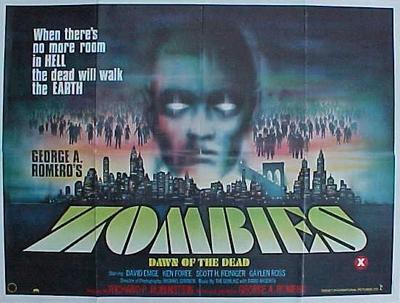Dawn of the Dead (George A. Romero, 1978): Class Handout

Released in 1978, Dawn of the Dead is a sequel to Romero's 1968 classic Night of the Living Dead. In Night of the Living Dead, Romero reinvented the zombie movie: until Night... zombies had been presented in the traditional manner, as the mindless slaves of voodoo priests (see Plague of the Zombies, John Gilling, 1965). In Night... Romero created the zombie as undead monster, feeding on warm human flesh; but as one of the characters notes in Dawn... the zombies are not cannibals—their feeding is intra-species (the dead feeding on the living), not inter-species. Additionally, no concrete explanation is given for the appearance of zombies in his films: they are just a fact of existence which the heroes have to deal with. In Night... and Dawn... the heroes try to come to terms with living in a world overrun with zombies, and tellingly by the end of Dawn... the zombies have become largely a simple nuisance: the heroes have become accustomed to their presence (and for a central portion of the film, they seem to ignore the zombies altogether).

In the three films that form his 'living dead' trilogy (Night..., Dawn... and Day of the Dead, 1985—a fourth movie, Land of the Dead, is due out this Summer), Romero uses the zombie to comment on pressing social issues, and he is one of the few mainstream filmmakers who are happy to talk about the social and political content of their movies.
In Night of the Living Dead Romero gave a starring role to the young African-American actor Duane Jones, and the film obliquely comments on the issue of racial prejudice in 1960s America (remember, 1968 was the year of the Watts Riots). In addition, the film deals with the paranoia of the Vietnam era, and the bickering between different social factions.
In Dawn of the Dead, Romero traps his heroes in a vast shopping mall (the Monroeville Mall in Pittsburgh). Significantly, the late 1970s saw the growth of 'mall culture' in America, and in Dawn... Romero comments on this growing fascination with consumerism and material possessions. He uses the figure of the zombie as a metaphor for the mindless mindset created by consumerism, and he uses cannibalism as a metaphor for the way in which people relate to one another in a consumerist society (he is suggesting that in a society dominated by commerce and money, people compete with and 'feed off' each other). Watch how the film's heroes become increasingly fascinated with the material goods in the shopping mall, and see how their relationships deteriorate because of this: they become no better than the zombies they have trapped outside the mall—they display the same mindless fascination with consumption (flesh, stuff—it's all the same).

Additionally, there is the suggestion of a gay relationship between Peter (Ken Foree) and Roger (Scott H. Reiniger); this is not surprising, considering Romero is one of the few mainstream genre filmmakers to make films (e.g. Knightriders, 1982) in which the central characters are gay—with Night of the Living Dead, he was one of the first genre filmmakers to give a starring role to a black actor.
What is the central question of Romero's zombie movies? I think it's this: Can a fallen society rebuild itself?
In Night of the Living Dead Romero gave a starring role to the young African-American actor Duane Jones, and the film obliquely comments on the issue of racial prejudice in 1960s America (remember, 1968 was the year of the Watts Riots). In addition, the film deals with the paranoia of the Vietnam era, and the bickering between different social factions.
In Dawn of the Dead, Romero traps his heroes in a vast shopping mall (the Monroeville Mall in Pittsburgh). Significantly, the late 1970s saw the growth of 'mall culture' in America, and in Dawn... Romero comments on this growing fascination with consumerism and material possessions. He uses the figure of the zombie as a metaphor for the mindless mindset created by consumerism, and he uses cannibalism as a metaphor for the way in which people relate to one another in a consumerist society (he is suggesting that in a society dominated by commerce and money, people compete with and 'feed off' each other). Watch how the film's heroes become increasingly fascinated with the material goods in the shopping mall, and see how their relationships deteriorate because of this: they become no better than the zombies they have trapped outside the mall—they display the same mindless fascination with consumption (flesh, stuff—it's all the same).

Additionally, there is the suggestion of a gay relationship between Peter (Ken Foree) and Roger (Scott H. Reiniger); this is not surprising, considering Romero is one of the few mainstream genre filmmakers to make films (e.g. Knightriders, 1982) in which the central characters are gay—with Night of the Living Dead, he was one of the first genre filmmakers to give a starring role to a black actor.
What is the central question of Romero's zombie movies? I think it's this: Can a fallen society rebuild itself?

Other recommended movies by Romero:
The Crazies (1973), Martin (1975), Jack's Wife (1973), Monkey Shines (1988), Bruiser (2000)
©Paul Andrew Julian Lewis, 2005


0 Comments:
Post a Comment
<< Home